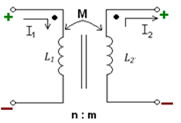Projects:2015s1-71 Inductive Power Transfers
Aims
The aim of this project is achieving the inductive power transmission from a primary coil to a secondary coil, meeting at least 70% efficiency, through 500mm air gap and transferring 5W power to the receiver. Meanwhile, the size and weight of the inductive power transfer, which will be built, will also be minimized.
In the end, the project aims to build an inductive power transfer which can successfully charges a mobile phone-sized device with above requirements.
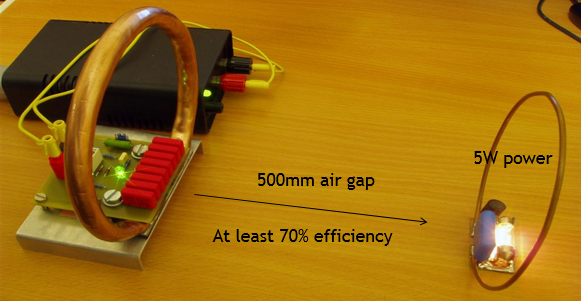
Motivation
The project being undertaken is because as the technology has developed very sharply recent years, many new types of devices are produced which leading to the situation that everyone has many equipments need to be charged every day. However, firstly the bunch of wires and cables are easily tied with each other which is annoying and bothered, secondly, the exposure wires may have chance to hurt people. Finally, the wires and cables are easier affected by the extreme weathers. Therefore, this project has been focused on cause if it is successfully achieved, it would makes the differences that the working environment which full of devices will be beautified and people would not be bothered by finding no public charger in public place anymore. Then the safety of people who use them would be ensured. Finally, the wireless technology is more stable. In addition, according to the huge demand on the inductive power transfer technology, it is not only focused by engineers, but also concentrated by many commercial companies because it is also a commercialized technology which can makes many benefits, specifically, Oskar Rönnbäck(2013) [9] describes that during the next 10 years, according to the evaluations, the wireless power could be a billion dollar industry. Therefore, it will plays a critical role in the future electric market.
Significance
Oskar Rönnbäck(2013) [9] illustrates that there are benefits can be obtained from the wireless power system. The first is the environmental benefit. If the global medium-range-wireless standard is met, all the mobile devices can be charged by one wireless system which means many charger would be saved and also the numbers of using batteries would be reduced. Secondly, the social benefit is that the charge zones will be established in many publics which is convenient for people who carries many chargers every day.
Background
The inductive power transfer is a kind of wireless technology which is a electrical transmission from a power source to a receiving device without wires and cables between them. It is also belongs to the non-radiative technique which also called near-filed wireless power technology. Umenei, A. E. (June 2011) [14] illustrates that the energy of the primary coil stays at a short distance to the transmitter, when there is no secondary receiver arranged, the power would still around the transmitter rather than leaving it. Additionally, there are many applications we using in our daily life are under this technique such as electric toothbrush charger, electric vehicle charger, smartcard and so on. The wireless technology is one of the main advanced technology in the modern life, however it is an old technology. The inductive power transfer had been invented in 1800s when the transformer was developed (Oskar Rönnbäck 2013) [9].
Electromagnetic theory
There are some basic theories will be integrated and used to support the electromagnetic theory.
According to [1], Ampere’s Law defines that the electric current passing through a closed wire loop will produce a corresponding magnetic field around the loop as the following figure 2 shows.
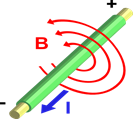 Faraday’s Law defines that the wire loop in the varying magnetic field will produce a voltage which called induced electromotive force (EMF) as shown by Sadiku [2], and Michael and Davidson [5].
According to [3] and [5], Lenz’s Law defines that the induced EMF, which was introduced in Faraday’s Law, will generate an induced current and hence induced magnetic field in the closed wire loop to suppress the change of the original magnetic flux.
Electromagnetic theory is considerably important for wireless power transfer, because it can be applied to replace the solid wires. The following paragraph introduces it in detail.
The figure 3 shows the electromagnetic field in a simple transformer, and the figure 4 is its detailed schematic diagram. Lincolncentral [4] shows in figure 4, the left part shows the primary winding which is injected with an AC current, and hence a variable magnetic field is generated around the winding. The secondary winding in this magnetic field will produce a varying induced EMF. Consequently, in the secondary winding an induced current will follow and create an induced magnetic field whose direction is oppose to the primary magnetic field as the right part shows. Additionally, the role of the induced magnetic field is to suppress the change of the primary magnetic flux and hence keep the magnetic flux constant.
Faraday’s Law defines that the wire loop in the varying magnetic field will produce a voltage which called induced electromotive force (EMF) as shown by Sadiku [2], and Michael and Davidson [5].
According to [3] and [5], Lenz’s Law defines that the induced EMF, which was introduced in Faraday’s Law, will generate an induced current and hence induced magnetic field in the closed wire loop to suppress the change of the original magnetic flux.
Electromagnetic theory is considerably important for wireless power transfer, because it can be applied to replace the solid wires. The following paragraph introduces it in detail.
The figure 3 shows the electromagnetic field in a simple transformer, and the figure 4 is its detailed schematic diagram. Lincolncentral [4] shows in figure 4, the left part shows the primary winding which is injected with an AC current, and hence a variable magnetic field is generated around the winding. The secondary winding in this magnetic field will produce a varying induced EMF. Consequently, in the secondary winding an induced current will follow and create an induced magnetic field whose direction is oppose to the primary magnetic field as the right part shows. Additionally, the role of the induced magnetic field is to suppress the change of the primary magnetic flux and hence keep the magnetic flux constant.
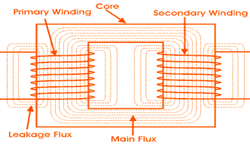
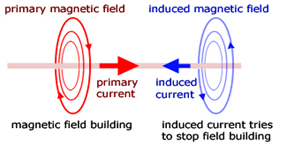
Coupling
Coupling occurs when the change in current of one inductor induces a voltage in another inductor. According to the electromagnetic theory mentioned before and [5], coupling happens between the two windings of transformer, and the mutual inductance M can represent it as the following figure 5 shows. Among them, L_1 and L_2are the primary and secondary self-inductances, and coupling factor K is introduced to represent the relationship between self-inductances and the mutual inductance. The formula is K=|M|/√(L_1*L_2 ). Moreover, in order to simplify the transform circuit, the T model equipment circuit is used shown in the figure 6. The main profit of the T model equipment circuit is to convert the virtual electromagnetic field and coupling into an actual circuit diagram, which is benefit to analyze the transformer circuit.
